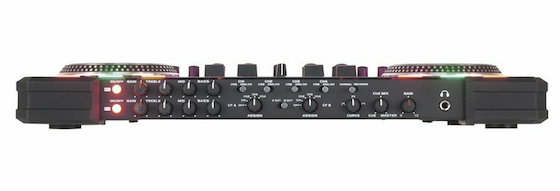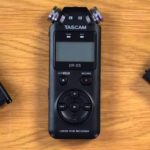Video Review
On paper, the American Audio VMS4, which the VMS4.1 that we’re reviewing today replaces, looked like a real bargain. It had more features than just about any DJ controller out there at any but the highest of prices appeared well made and seemed to offer a level of versatility unmatched by anything other than top-of-the-range gear from the likes of Allen & Heath.
Turned out though, that this (admittedly very affordable) controller had issues which for many were deal-breakers: The main one was average audio, but there were also reliability issues reported by a larger than normal number of users. While some loved it, for many it was ultimately – despite its metal and rubber, workmanlike externals and a plethora of controls – a work in progress.
No doubt reacting to that initial user feedback, the company countered with today’s unit, the American Audio VMS4.1 for Virtual DJ (and also with the VMS4.1T, a version for Traktor). Question is, has it managed to fix that main error – sound quality? And how does the VMS4.1 stand up against the competition, nearly two years down the line?
First impressions and setting up
If you aren’t familiar with this controller or with its little brother, the American Audio VMS2, they are basically old school beasts of devices. Reasonably big (about the same size as a Vestax VCI-400, maybe a little wider), the controller is made of painted, polished metal, with huge rubber corners. With it in the box are a power cable, instructions, Virtual DJ CD (with ASIO drivers for PC people, not necessary for Mac), a sticker and a USB cable.
It’s durable, heavy and feels like a piece of utilitarian gear rather than a design classic, an image reinforced by the decidedly old-school jogwheels, which have translucent, easily removed rubber rims around them (more about those later).
Controls, inputs and outputs
The unit is notable for the number of controls it has: The top has four full mixing channels; booth and master outs knobs (with balance); and a set of touch controls (mouse pad, load buttons, and touchstrips).
Each deck has controls for sampler and FX; cues (four per side, with shift doubling up); keylock; vinyl/nudge switching; pitch bending; and of course, the ubiquitous transport, pitch slider and sync buttons.

Round the back it becomes apparent how versatile the design is: there are two combi mic inputs (XLR and 1/4″); four RCA-ins for up to four analogue sources (two line-only, two switchable line/phono) plus earth poles; outputs for booth and master (RCA) plus balanced XLR master outs; 1/8″ sockets for compatible fader start decks; and the usual USB and power sockets (it is a standalone mixer as well as a Midi controller, so it needs mains power) plus an on/off switch.
Meanwhile, the front of the unit features on/off plus gain and full three-band EQ for not one but two microphones; switching between USB and analogue and channel routing controls for all four inputs, Xone DB style; a sound card behaviour switch for using either four software decks or routing two external sources through software (for digital vinyl, for instance); crossfader curve and reverse; plus cue mix and gain for the 1/4″ headphones socket.
Setting up involves installing the ASIO drivers if you’re on a PC, installing Virtual DJ LE VMS4.1 version, plugging in and turning on.
There are absolutely no configuration options in the LE version of Virtual DJ that’s supplied, which is a great thing for getting going, but it means that as we’ll find out, you’ll want the full version of Virtual DJ for pro use.
In use
The VMS4.1 feels solid and dependable. It’s heavy, so once you start using it it isn’t going to slip and slide. The skin for Virtual DJ is well mapped to the controller, although there are elements missing that will become annoying to you over time. (One bugbear: no dedicated switch for swapping deck layers, although a reader has pointed out that pressing shift and pause together seems to do the trick for him. A dedicated button has been added to the Traktor version, apparently.) But overall it feels up to the job.
Touch controls
I didn’t like the touchpad for controlling your computer mouse. It’s a neat idea, but on my Mac, it moved far too slowly, and I didn’t seem to be able to make any difference to the behaviour via the control panel on my computer. Nonetheless, it’s better than nothing for hitting the odd control you can’t find a hardware mirror for. Just try not to touch it by mistake…
There is two vertical touchpads either side of the mixer, and these are a neater idea; you can map them to anything with mappable software, but as supplied they scroll through your current files (right) and folder tree (left). In the latter case, though, once you’ve reached a folder, I couldn’t see how to “select” it from the hardware.
Transport and jogs
The buttons underneath the jog wheels are a cue, play and pause – normally you’d have a sync button here and the play and pause would be on the same button. As it is I kept thinking they were (they are on most controllers, and they are on the Traktor version of this one). This just takes some getting used to; there’s nothing inherently wrong with it. The sync, by the way, is unobtrusively tucked away up by the pitch faders.

Ah yes, the jogwheels. These are the most low-fi jogs I’ve ever seen! Made in kind of hollow metal, they have grooves on like a record, and kitsch strobe dots like the platters of Technics turntables. Then, over their edges is stretched translucent plastic!
The purpose of this is to make the top of the jog function for scratching, and the edges as nudge (they work electrically on touch, so the rubber insulates them from your fingers). But it feels like an afterthought, is not going to be particularly durable, and doesn’t look very good.
Faders and buttons
The crossfader is good, though, and it’s Innofader compatible so you can switch it out for a scratch fader should you wish. Likewise, the crossfader curve is a nice addition, but really, scratch controls (including the reverse button) are a bit superfluous when the jogs are so-so as these are.
Most knobs have lit red strips in them to show where they’re set in the dark, which is great. Likewise, the line faders feel solid enough, and the knobs are rubberised. A nice touch here is that the Master volume has an orange strip. They’re mainly centre-click but some stepped, depending on function.
The unit’s buttons are nice, too – they’re backlit white rubberised little rectangles, mainly blue but some red, and Pause breaking with the scheme, in green and orange respectively.
Control over the samples and FX (notwithstanding the latter being limited on the LE software) is simple and intuitive with the supplied controls; looping works in a completely standard way for manual looping, although accessing beatmatched looping is a little fiddlier; and the four hot cues per side work how they should, with shift plus the button deleting them.
Advanced use
Some of the power of the unit is under the surface. You can switch the sound card to operate across four software channels, or you can have it operating across two, with two of the analogue channels feeding into the software (to carry DVS timecode, typically, which is possible with Virtual DJ DVS).

The EQ can be switched to either software or hardware, and Virtual DJ can even be mapped so that even if the standalone mixer is doing just that – operating as a standalone mixer – the controls on the screen still “move” despite not doing anything in reality. This is neat and shows thought and planning in the Virtual DJ mapping.
Note however that to do any of this stuff, you need to upgrade your software – the supplied software, as I mentioned, has no configuration available to the user at all. Also, if you’re on a Mac, the instructions in the box are limited for advanced audio configuration, so you’re going to have to have some experience or get forum digging when you want to start tweaking things.
The microphone channels, by the way, are completely hardware, being routed nowhere near the computer under any option.
Sound quality
I didn’t get to test the original, but the sound quality from the VMS4.1 is fine. Should you be interested, the THD is quotes at 0.045%, s/n at 97dB, frequency response 20Hz-20kHz, +/-0.3dB. I’m assuming it’s 16 bit, 44.1kHz but that’s just my guess as the spec is missing this final info.
I’m not a fan of numbers, though. I prefer the ears. I listened to it through our current test monitors, the KRK Rokit 10-3s, so any major shortcomings would have shown up right away, but it sounded full and engaging, with nothing jumping out as below par. So you can safely assume if you’re interested in buying this unit that any issues from the VMS4 have indeed been sorted out.
Finally, the headphones volume was easily enough – as you’d expect from a DJ controller with mains power.
Conclusion
When the VMS4 came out, I wanted to like it, as it offered so much for the price. But before we got to review it the so-so news about the sound card hit and our review never happened. However, I’m pleased to say that that particular bugbear has been put to rest, so for that reason alone, I guess the VMS4.1 can be judged a big improvement.
Additionally, while it’s hard to test overall reliability in a day’s playing, it seemed well made and felt like it would last the course. I assume if there were any glaring manufacturing issues, American Audio would have taken the chance with the 4.1 version to right them.

Value-wise, on the surface it’s cheap – it comes in at around £330, or US$434, which for a standalone four-channel Midi mappable mixer, two Midi decks, a versatile sound card, booth and master outputs, two EQ-able mic channels, and some smart Midi stuff that means you can slot this in at the heart of some pretty esoteric set-ups, seems good value.
But when you add in US$299 for the software, it’s really not so cheap. This is not the fault of American Audio, but with Traktor now almost a giveaway in comparison, all controllers relying on a full version of Virtual DJ to truly complete are looking expensive indeed. I wouldn’t be surprised if Virtual DJ doesn’t alter its prices soon.
The American Audio VMS4.1 isn’t going to appeal to controllerists or scratch DJs, nor those looking for gear they can perform to the highest level on by pushing it to its limits – it’s not really aimed at that kind of market.
It’s aimed at mobile /wedding/hobbyist DJ who would rather have features over absolute best performance. If that sounds like you, you should look into it – especially if you already own Virtual DJ Pro, as in that case, you do get a decent amount for your money. Just make sure you can live with those rubber-sheathed old-school jogwheels.
Have you bought this unit? Do you gig regularly on it? Did you buy the original? Please let us know your thoughts in the comments.








